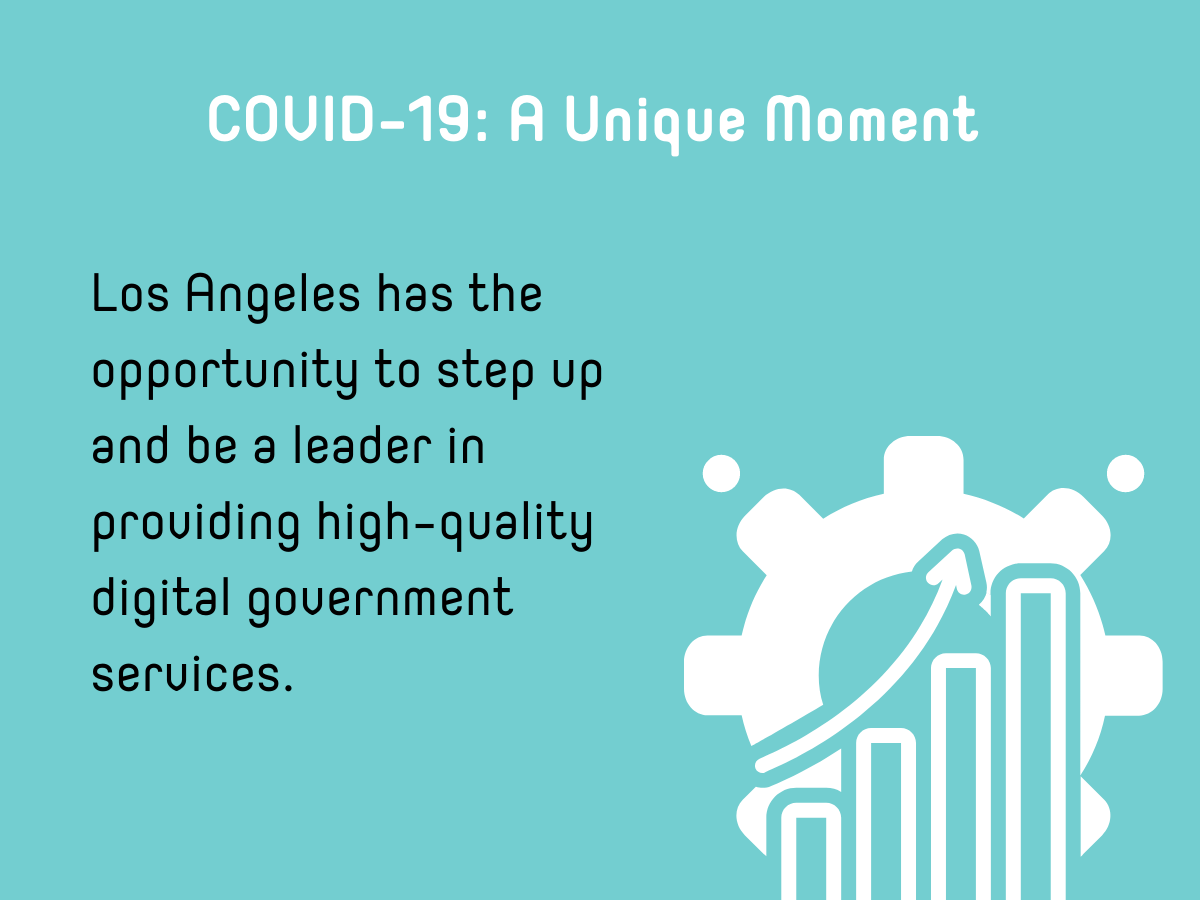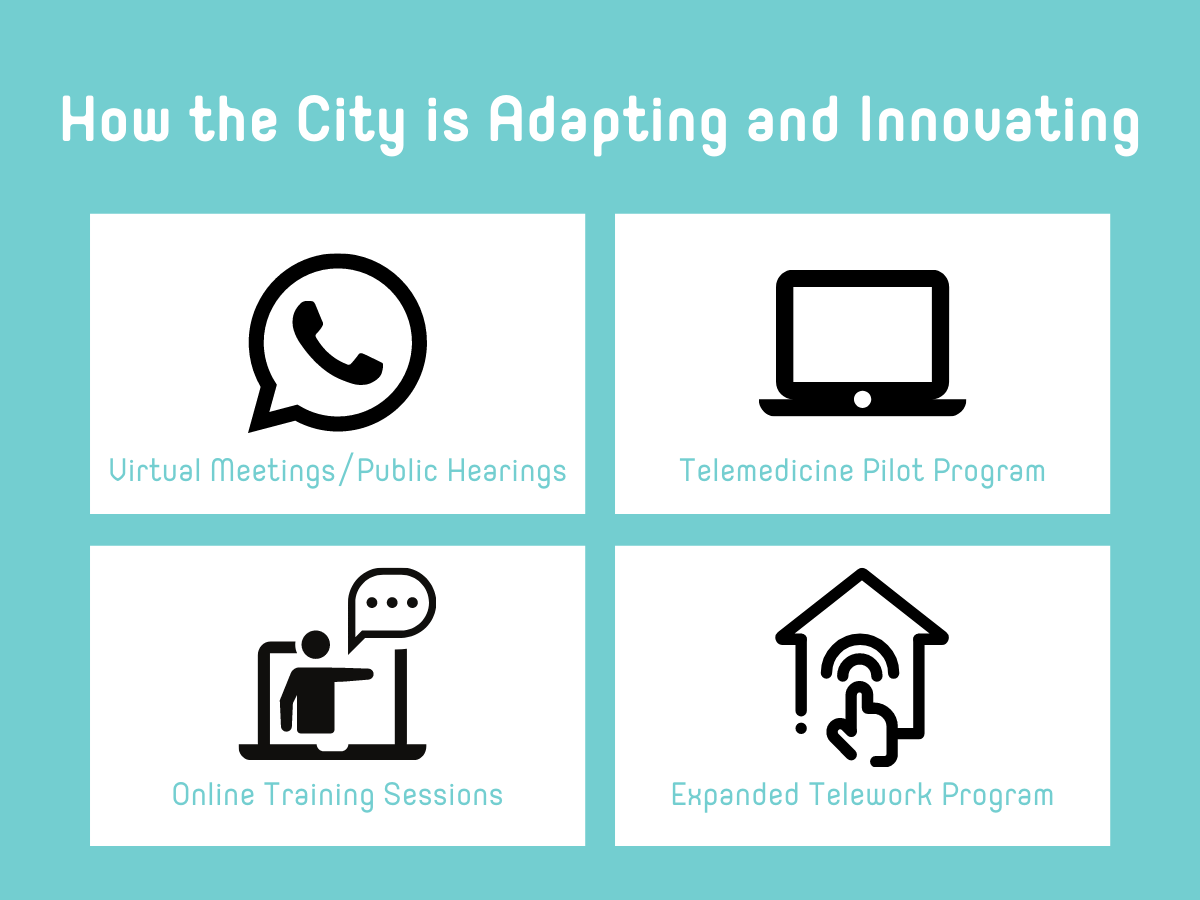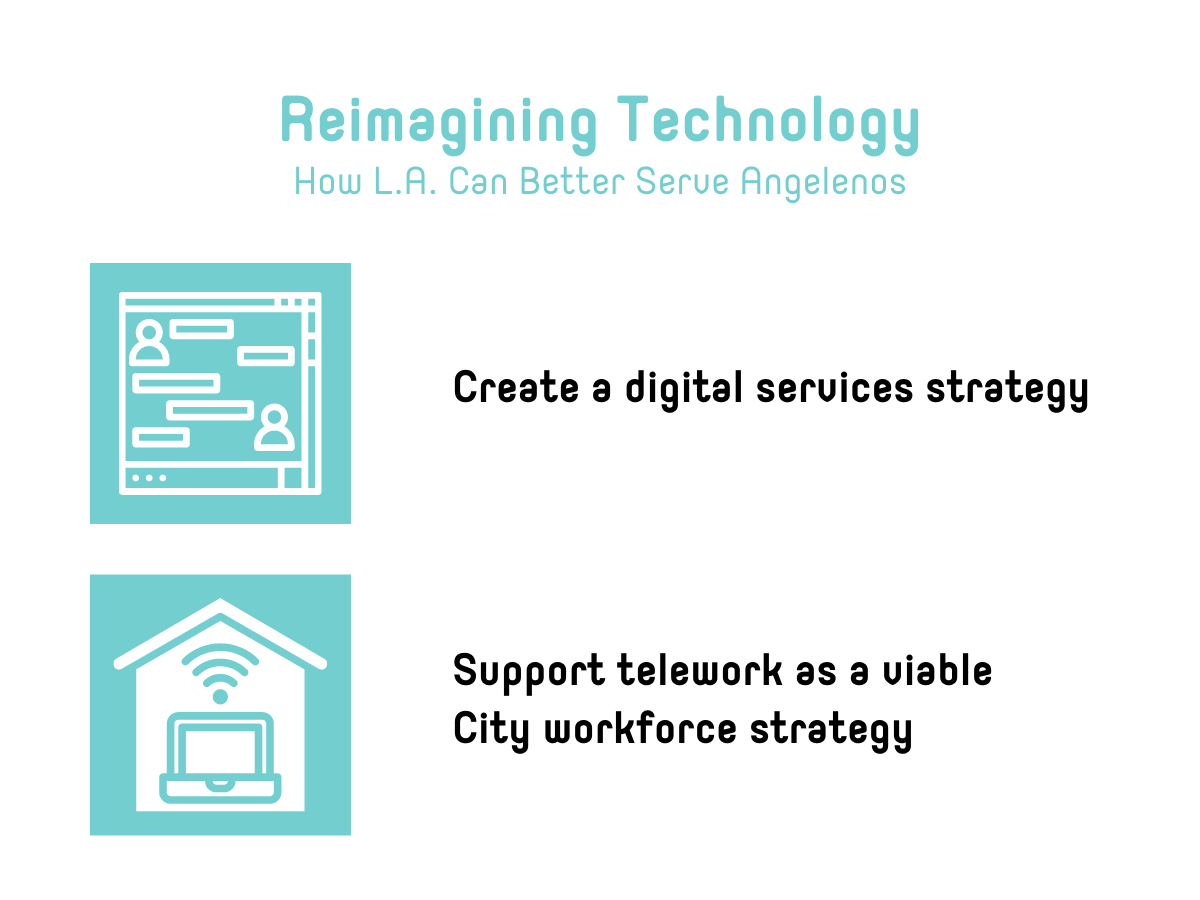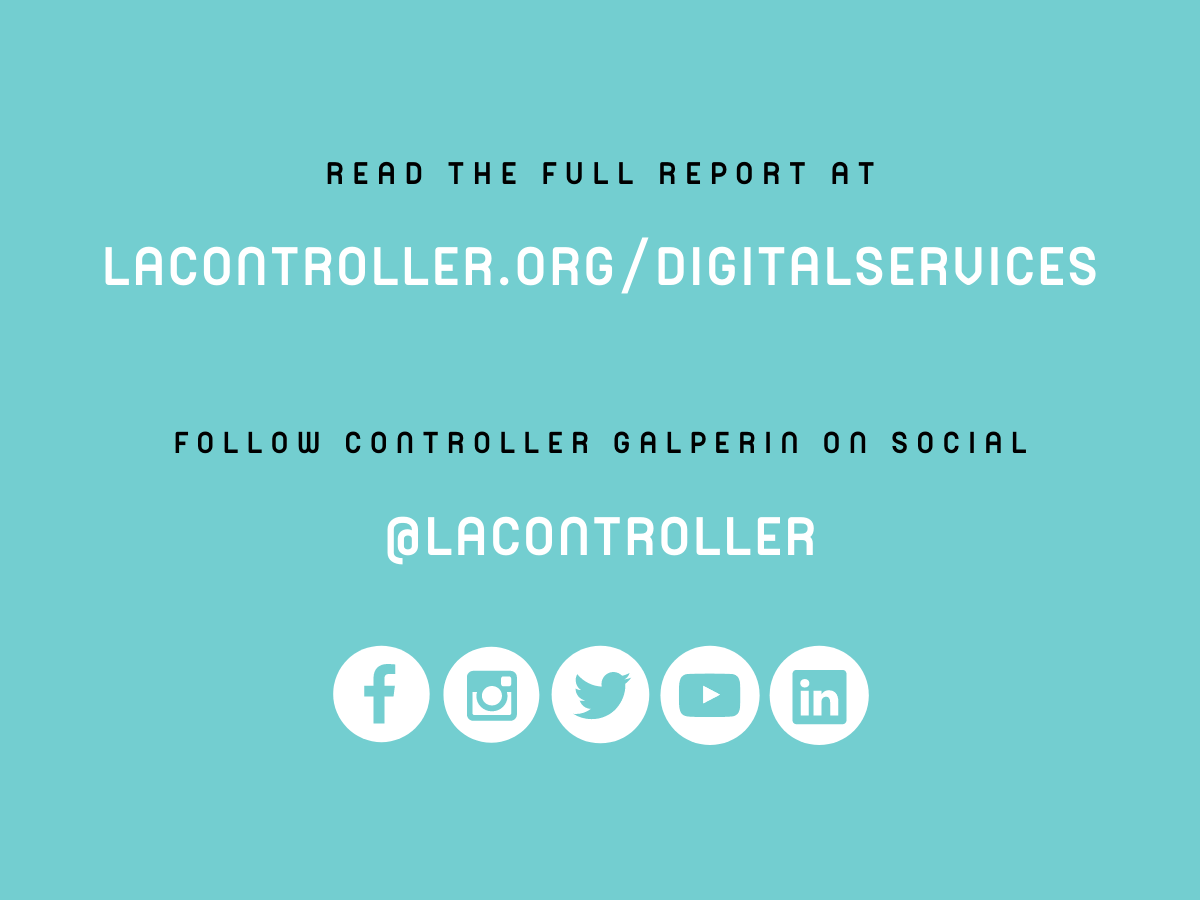A Stronger Connection: Expanding Digital Government Services
2020 City of Los Angeles
Report
The City of Los Angeles offers numerous services that Angelenos count on. Traditionally, City services have been delivered in-person, at different locations, and with paper forms, if required — and City workers have shown up to designated worksites each day. While in-person assistance is necessary in certain circumstances and preferable in others, it is not always the most effective way to get residents the help they need. The City’s ability to deliver digital services and the steps it must take to improve them, including by integrating telework into the City’s operations, is the subject of this report.
Each bar below contains a section of the report. Click on any to expand and read the full text of the section. Click again to collapse.
September 30, 2020
Honorable Eric Garcetti, Mayor
Honorable Michael Feuer, City Attorney
Honorable Members of the Los Angeles City Council
Re: A Stronger Connection: Expanding Digital Government Services
Local government exists to provide representational and administrative leadership to constituents living within specified geographical boundaries. The City of Los Angeles strives to do both as well as possible. On the representational side, the goal is to involve residents in determining local public needs and how these needs can be met. Administratively, the City and its 44,000 employees offer numerous services that Angelenos count on, such as trash pickup, permitting and inspections, street and tree maintenance, public safety, park preservation, youth and senior services and more. Traditionally, City services have been delivered in-person, at different locations, and with paper forms, if required — and City workers have shown up to designated worksites each day.
While in-person assistance is imperative in certain circumstances and preferable in others, it is not always the most effective way to get residents the help they need. People expect their interactions with the government to be as seamless and simple as possible, similar to the best private sector customer service providers. The City’s current ability to deliver digital services and the steps it must take to improve them is the subject of my current report.
Benefits of digital government
Los Angeles has moved toward improving its digital service delivery in recent years, and with the unexpected global pandemic these efforts were pushed to the fore. COVID-19 made some in-person services, such as those at customer counters, nearly impossible and forced many City employees to work virtually. Despite the challenges posed by the coronavirus, it also served as a catalyst to implement digital innovations or accelerate projects already underway, including hosting virtual meetings to facilitate public hearings, rolling out a telemedicine pilot to reduce ambulance dispatches, developing online training sessions for seniors and scaling up a largely unused telework program from 30 employees to 10,000 to keep City workers safe.
These innovations, largely born of necessity, deserve to be examined and expanded, accompanied by a unified plan to broaden digital services and improve the customer experience for all Angelenos. The Mayor’s Executive Directive 29, urging more contactless services, is a step in the right direction. Before the City fully re-opens its offices to the public, it needs to thoroughly reassess its ability to deliver the digital services residents expect and deserve.
My office found that Los Angeles currently has much room for improvement, as many services that could be done online or remotely — certain permits, reservations, registrations, inspections and more — still rely on paper or must be done in person. This is primarily because there is no overarching City strategy to enhance digital service delivery. As of now, it is left up to departments, resulting in a fragmented approach. The City should use this unique period when online services are required to develop greater digital options that bolster existing services.
Growing the City’s digital capabilities must also mean empowering the workforce and the people it serves. Many City workers have found that they can not only successfully telework, but have been happier and more productive doing so over the last six months. Institutionalizing this new efficiency should be a priority. And, as a matter of equity for those served, broadband accessibility must be part of the discussion. Areas of the City where access to broadband is spotty or nonexistent cannot be left behind. My report posits that these factors need to be considered while planning strategically to expand digital service options. If done properly, this could allow far more people to access City services, and also lead to an improved customer experience, better performance and a stronger connection to our City overall.
Reimagining services
As the City continues to adapt to the difficulties posed by COVID-19, it should reimagine the way it uses technology to deliver services, both for City employees and the people they serve. My report makes the following recommendations:
- Adopt a digital services strategy that includes the City’s overall vision, objectives, and plan for providing digital services to the public. The strategy should be drafted by a working group or committee consisting of staff from City departments, Council, and the Mayor’s Office, with significant input from the public, and include clear goals and a road map to ensure its success.
- Adopt a framework to support telework as a viable City workforce strategy, with implementation led by the Personnel Department, and require all departments to develop a policy to determine eligibility for their employees.
There is no better time to adopt a novel approach to digital services that aligns with the City’s values and places customer and employee needs first. Innovation need not wait for the pandemic to end or for another challenge to begin. I urge City leaders to adopt a forward-thinking plan that both benefits and engages more Angelenos.
Respectfully submitted,

RON GALPERIN
L.A. Controller
COVID-19 has presented a number of challenges for government, with social distancing requirements placing limits on services that still require paper inputs or in-person delivery. However, COVID-19 has also served as a catalyst to implement new innovations or accelerate projects already underway. Within the City of Los Angeles, those ideas and projects include:
- hosting virtual meetings to facilitate public hearings for the City’s land use development process and Neighborhood Council meetings;
- developing online training sessions for family caregivers of older adults while the City’s multi-purpose senior centers are closed;
- rolling out a new telemedicine pilot to monitor low-acuity patients, reduce ambulance dispatches, and reduce overcrowding in emergency rooms; and
- scaling up its telework program to ensure that City employees can continue working while limiting the risk of exposure and spread of COVID-19.
In addition, emerging technologies representing potentially huge shifts in society have also found applications in other jurisdictions.

Virtual agents powered by artificial intelligence have been deployed to deal with overwhelming call volumes related to COVID-19 and unemployment questions.

Mobile phone applications are being developed to aid COVID-19 contact tracing efforts while maintaining privacy through blockchain encryption.

Governments at all levels are looking to virtual and augmented reality to help with community engagement, firefighting, and training.
However, as the City gradually re-opens, it should continue reassessing its processes and deliver the digital services that Angelenos expect and deserve. The City has a long way to go – many services, payment options, and internal processes still rely heavily on paper or in-person service delivery. Instead of simply returning to these outdated processes, the City should continue its momentum and develop even more digital options to supplement existing services.
At the same time, barriers to accessing a computer and high-speed internet, especially among lower-income households, means that the benefits of online services are less likely to reach those with the greatest need. Within the City, this digital divide is particularly true in low-income areas like South LA. These facts are even more pronounced during COVID-19 as more activities are brought online, making internet access an essential service. More digital inclusion programs — like the City’s OurCycle LA project to provide computers to underserved communities — are needed to bridge this gap.
Creating more digital service options while planning strategically – As the City gradually moves towards re-opening, our difficult fiscal environment also means that we must do more with less. New technologies can empower City employees to meet increasing demand while allowing them to focus on work valued by the people we serve. In that vein, the Mayor’s recent Executive Directive 29, which also advocates for more digital and contactless government services, is a step in the right direction.
In addition, growing the City’s digital services holds the promise of many other benefits, including:
- increased accessibility;
- improved customer experience;
- enhanced City performance; and
- more civic engagement.
Some specific opportunities include replacing more of its paper applications (e.g., reducing the paper products it issues such as residential parking hang tags) and supplementing in-person services, such as field inspections, with virtual options.
While the benefits are clear, the question remains about how to effectively coordinate and implement these initiatives across a decentralized network of City departments – each with its own unique set of processes and priorities. The City’s Information Technology Agency (ITA) provides direct IT services and support for the City, and advises other City departments on their technology projects. However, ITA’s role as a consultant and support unit, combined with the City’s culture of departmental autonomy, limits its ability to strategically coordinate the use of technology across the City.
This limitation was also recognized by the City’s Innovation and Performance Commission. As part of its mission to identify and support ideas to improve City government, the commission voted in 2015 to fund a pilot program that worked across the City to develop new digital services. Although no longer funded, the pilot program provided important lessons on how the City should collaborate to develop digital services. Other cities, such as San Francisco, have taken a more deliberate and sustained approach by adopting a longer-term strategy for implementing shared digital services.
The City should also develop a digital services strategy that provides direction and leadership for its public-facing services. The lack of a unified strategy in the City has resulted in fragmented digital services of varying quality. For example, simple building projects that only require permits from the Department of Building and Safety can be obtained entirely online. However, larger projects may require additional approvals from many other departments, each with their own method for applying, submitting documents, and paying for inspection fees.
Although Building and Safety is currently working with other departments to incorporate their permitting services into the same online platform, the current lack of a unified permitting system and process means that contractors and other customers must continue navigating through the City’s disjointed development process.
Fragmented processes like these can be improved with the help of a digital services strategy that aligns departments toward a common set of values that places customer needs first, promotes cross-department collaboration through a new governance structure, and empowers a digital services agency to work with departments to execute new projects.
Adopting requirements and best practices to sustain telework – The City’s forced experiment with telework during COVID-19 has shown that it can strengthen business continuity planning. At the same time, studies have shown that telework can also increase productivity, increase recruitment and retention, and even reduce real estate and other costs.
To ensure that telework remains a critical part of the City’s workforce strategy and emergency planning, the City should adopt certain requirements and best practices from the federal government to provide institutional support for the wide implementation of telework even after the pandemic has subsided. These include requiring departments to develop telework policies with eligibility and participation criteria that fit their operational needs, determining eligibility, and notifying employees of their eligibility to participate in telework.
Conclusion and Recommendations
COVID-19 has created a new normal that the City is still navigating. However, that new reality is also one that includes more digital services than ever before. The City has demonstrated its ability to adapt and should continue rethinking its processes and creatively using technology to improve its customer service for all Angelenos.
To build on these existing efforts, City Policymakers should consider the recommendations in this report to serve as a guide for developing a collaborative digital services strategy. In addition, the City’s support for telework as a workforce and business continuity strategy hinges on its adoption of the recommended best practices.
Recommendation #1
Consider developing and adopting a digital services strategy that includes the City’s overall vision, objectives, and plan for providing digital services for the public. At minimum, the strategy should include:
- creating or designating a working group or committee to guide the strategy’s development, consisting of staff from City departments, Council, and Mayor’s Office to promote collaboration and accountability;
- developing shared values and goals for the City’s digital services based on the successes and challenges of implementing services online. This effort should also include significant public input to address digital equity issues and the needs of the City’s customers and end-users; and
- establishing a high-level road map for achieving its goals, which should include consideration for a new governance structure, such as a committee that is empowered to prioritize and oversee digital service projects and promote collaboration across the City, and the need to create a digital services unit within the City that is dedicated to providing digital leadership in the City and implementing its strategy.
Recommendation #2
Implement program changes through executive or legislative action to adopt a framework of requirements — similar to those enacted at the federal level — that support telework as a viable workforce strategy for the City. At a minimum the City should:
- assign responsibilities to Personnel and the departments to support and implement telework Citywide, even as the pandemic eventually subsides;
- formally incorporate telework into its emergency planning processes;
- require all departments to develop a telework policy that includes eligibility and participation criteria;
- determine telework eligibility and inform all workers of their eligibility; and
provide training to all employees and supervisors participating in telework to improve productivity and success.
Under normal circumstances, the City of Los Angeles is responsible for delivering many different services to the public. These range from street sweeping and garbage pickup that come to residential homes, to YouthSource and WorkSource centers with walk-in access to a variety of resources such as job skills training.
In addition, the City has made strides in recent years to put content online and expand its digital presence. Although the availability and quality of the City’s digital services vary from one department to the next, the number of services have grown to include:
- digital library services and its large collection of electronic media, including e-books, streaming options for movies and music, and online learning resources;
- online application for business registrations with the Office of Finance;
- permit application, plan check review, and payment through the Department of Building and Safety’s ePlanLA online platform;
- MyLA311 website and mobile application to request certain services such as bulky item pickup and graffiti removal; and
- data portals, including Open Data and ControlPanelLA, to share the City’s data.
These services are provided by over 40 different departments and bureaus, each with their own processes, priorities, and capabilities. Supporting these departments is the Information Technology Agency (ITA), which provides both direct IT support and consulting advice to other City departments on their technology projects.
However, the City still has a long way to go. Many City services still require paper forms or in-person service delivery and COVID-19 threatened the City’s ability to deliver these same services. Suddenly, old processes, such as some payments and applications, that were still conducted on paper or in person could no longer function normally under social distancing limitations.
In the wake of COVID-19, the City’s responsibilities have also grown, as City employees are now coordinating virus testing, delivering meals to the homes of older adults, and operating emergency homeless shelters. Although COVID-19 will still have an outsized impact on the availability of some City services for the foreseeable future — such as for the zoo, public arts, parks and trails — investments in innovation and technology proved crucial for keeping certain services open during the pandemic.
To respond to this crisis, various departments throughout the City adopted new solutions to modernize processes and meet emerging needs. And while these technological efforts by individual departments are encouraging, a persistent issue in the City is the need for a more strategic approach. Other voices within the City, such as from the Innovation and Performance Commission, have also recognized this need to collaborate or expand existing efforts to improve the City. To this end, the commission has advocated for a Paper Free LA and to extend telecommuting across the City, while also voting to fund various pilot programs that are now demonstrating their value.
The City’s Digital Services Expanded During COVID-19
While calls for government innovation are constant, actual change is often incremental. Delivering change requires consensus building and resources, both of which take time and effort. However, COVID-19 has caused a burst of innovation in the City, accelerating the roll out of new programs and spurring the adoption of technologies at a fast rate. These and many more ideas deserve recognition because they demonstrate the City’s ability to quickly adapt and meet the needs of its constituents.
To highlight the City’s efforts to keep its public-facing services open, a selection of projects are presented below.
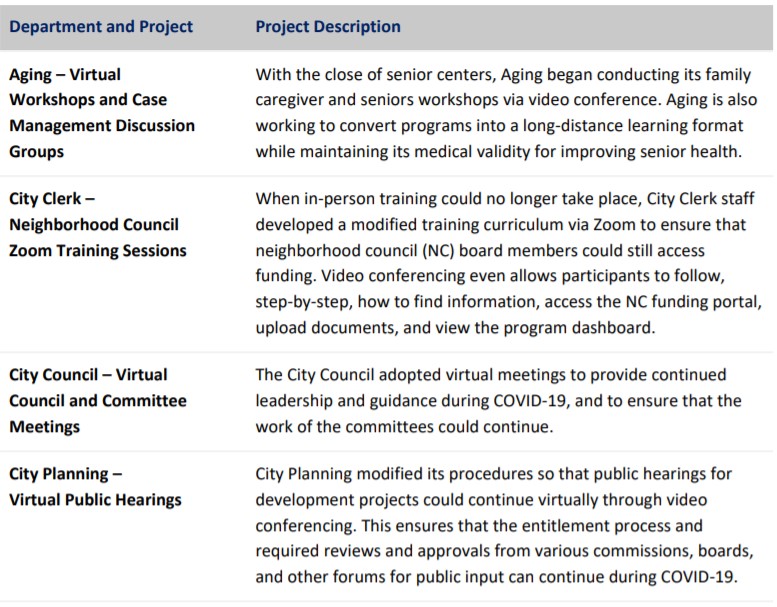

These new services, combined with existing digital services, have proven their worth as investments as they expand the number of service options while also facilitating continued civic engagement during COVID-19.
Telework Rapidly Expanded to Ensure Service Continuity
Prior to March 2020, fewer than 30 City employees formally participated in the City’s telecommuting program, which allowed staff to work from alternative locations other than their primary office. This quickly changed as COVID-19 was becoming a worldwide pandemic. On March 4th, the City declared a local emergency and found itself needing to balance the continuation of essential services with the protection of employees and the risk of spreading COVID-19. On that same day, City Council directed ITA and the Personnel Department to rapidly increase the City’s telework capabilities.
In response, ITA acquired new software and developed new protocols to facilitate secure remote computer access, while the Personnel Department developed a new set of telework procedures to prepare the City for the wide adoption of telework. These efforts, combined with existing investments in cloud platforms to host IT systems online, also enabled the City to quickly switch to telework. By March 19th — the day the Mayor issued the Safer-at-Home order — the City was able to support over 10,000 employees working remotely from home with the option to expand further as needed. Since then, about 50 percent of the City’s civilian workforce has worked from home in some capacity.
One of the many lessons learned from the City’s response to COVID-19 should be that smart investments in digital services and IT infrastructure have proven their worth. However, COVID-19 only accelerated this trend. Studies have shown that, more than ever, citizens expect high quality digital services from their governments.

Angelenos are no different in their need for an engaging and effective experience with their government. By one measure, demand for digital services has exploded: service calls to the City’s 3-1-1 telephone number have remained steady in the last seven years, while other forms of service contacts to 3-1-1, particularly through the MyLA311 website and mobile phone application, have more than tripled from 127,000 in 2013 to over 600,000 in 2019.
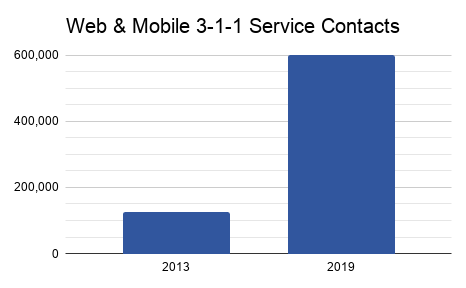
To meet this demand for more and better digital products, the City should continue the momentum generated by the crisis and expand its digital service offerings. As shown by the new and existing services provided by the City, developing more digital service channels can improve customer service, allowing residents to complete their transactions with the City in fewer steps and trips.
Redesigning the City’s collection of websites to emphasize end-user needs can also improve customer experience, while removing online barriers to increase digital accessibility. Implementing simpler workflows facilitated by technology can also improve the City’s performance. Finally, new avenues for virtual interaction can improve civic engagement for City processes that require or should have public input.
At the same time, the benefits of online services are contingent on having ready access to computers and the internet. Recent surveys in 2019 show that a digital divide still persists, with over 40 percent of low-income Americans lacking access to either a home broadband connection or a computer, compared to over 90 percent of high-income US households who do have access. Studies within LA County also show a similar gap in access, especially in lower-income areas like South LA. In addition, COVID-19 has only shed more light on this critical issue, with 87 percent reporting that the internet has been “important” or “essential” during the coronavirus outbreak.
However, digital inclusion programs can help reduce these barriers to access. One such program is the City’s OurCycle LA project, which seeks to close the gap by providing computers to participants in underserved communities. The City has also explored various options to provide high-speed internet access to low-income Angelenos but has yet to find a workable solution. More programs like these are needed as the City continues developing more digital services.
The City Should Do More to Expand Its Digital Service Offerings
Current and emerging technologies continue to offer new frameworks to reshape how the City delivers its core services. As demonstrated by its response to COVID-19, the City is capable of adopting new technologies when unforeseen circumstances require it to do so. Many City departments were pushed outside of their comfort zones during COVID-19 and expanded what they thought was possible when it came to service delivery.
As the City gradually moves towards re-opening, our difficult fiscal environment also means that we must do more with less. Technology can help by empowering City employees to meet increasing demand while focusing on work that is valued by the people we serve. Although the Mayor’s recent Executive Directive 29 is a step in the right direction and also advocates for more digital and contactless government services, more needs to be done. To this end, department leaders should continue to evaluate how their services are currently offered, how customers access services, and how to create new digital services and improve existing ones.
Some City processes still involve receiving and issuing paper – Despite prior efforts to reduce paperwork, some of the City’s public-facing services have not evolved beyond receiving paper because the logic of paper workflows still dictate its processes. Though paper will always play a role in City operations for reasons related to customer preference and accessibility, digital alternatives should exist. In addition, paperwork reduction for efficiency and environmental purposes need to be a top priority moving forward.
COVID-19 has demonstrated why digital service options should exist, as the closure of public counters has limited the number of options available to the public. This has forced the City to implement solutions that are less than ideal or secure, such as designated drop-off/pickup locations for customers to submit permit applications, planning documents, and payments for fees. Electronic or digital options, especially for processes such as payment, should already be widely available for the public.
Even in cases where some departments have switched to receiving documents via email, the minor improvements offered by a fillable electronic application are lost when the applicant has to print the form out to provide a hand-written ink signature and when a City employee has to re-enter that same information into a database.
However, online forms have long existed and can eliminate duplicative data entry. In addition, if more departments adopt the electronic signature platform used by ITA and integrate it with its forms, the City will be able to move beyond wet ink signatures.
In addition, several public-facing services also involve issuing “paper” products, such as hang tags for residential parking permits and business registration certificates. However, these paper products only serve to transfer the actual core service being provided. In the case of residential parking, permits signify the City’s approval for residents to use streets near their homes for long-term parking, and are part of a system for protecting access to street parking.
Replacing these paper products with electronic equivalents could save on costs and provide greater convenience for the City’s customers. For example, the cities of Boise, Idaho and Beverly, Massachusetts adopted electronic parking permit systems and processes. Boise and Beverly are now able to instantly issue e-permits based on car license plates and eliminate the need to mail physical permits. Boise has even coupled its e-permit parking system with license plate recognition technology to more efficiently and effectively enforce parking access.
Virtual interactions offer new service options – Replacing traditionally in-person services with virtual experiences is now a viable option for many City services. The Fire Department has already set this precedent with its use of drones to monitor and enforce brush clearance requirements and minimize fire hazards.
All City departments with field inspection functions should also explore the possibility of virtual inspections to supplement their current operations. Although it may not be appropriate for every situation, virtual inspections can provide City inspectors with eyes in the field without the need for boots on the ground. Beyond the need to reduce interpersonal contact, using virtual inspections can save travel time and costs, reduce the total time needed for inspections, and benefit customers by allowing inspections to be more precisely scheduled.
Many other cities and counties throughout the country have allowed certain types of projects to qualify for virtual inspections. For example, Los Angeles County offers virtual inspections for a variety of projects including installations for water heaters, solar energy systems, electrical panel change outs, and re-roofs. In addition, Atlanta has begun conducting virtual building inspections for fire and life-safety requirements.
Looking to the future, virtual and augmented reality (VR and AR) technologies that create new environments may also have a place in City government. Already, research is showing how urban planners can use VR and AR to create an immersive understanding of proposed designs and expand participation from affected communities. In addition, other VR and AR applications for firefighting and training hold the potential for rapid adoption.
A Digital Services Strategy and Unit Could Provide Leadership For the City’s Ongoing Digital Transformation
Although there are many ways to develop digital service options, the City also has many services already available online. The City’s MyLA311 service directory lists over 1,200 different entries, ranging from informational only, to departmental websites where services can be requested, to being able to create a service request within MyLA311 itself. However, many of these digital services were created by different departments to meet the specific needs of their own customers, sometimes resulting in confusion when related services are not well integrated.
For example, contractors and other members of the public may have relatively simple projects that only require a permit from the Department of Building and Safety, which can be obtained online through its Express Permit or ePlanLA systems. But undergoing a more complex building project, such as a major renovation for a new business, may require applications and permits from many other departments, including:
- Bureau of Engineering (Public Works);
- Bureau of Sanitation (Public Works);
- Bureau of Street Lighting (Public Works);
- Bureau of Street Services (Public Works);
- City Planning;
- Fire Department; and
- Transportation Department.
With the exception of the Bureau of Street Lighting, each of these other departments still have their own application, review, and payment processes outside of ePlanLA. Although Building and Safety is currently working with other departments to incorporate their permitting services into ePlanLA, the current lack of a unified online permitting system and process means that contractors and other customers must continue navigating through the City’s disjointed development process.
Even submitting a claim for a refund suffers from fragmentation. Although refunds are processed by individual departments that received the payment, all claims must go through the City Clerk’s office to receive a claim number for filing purposes, providing a common point of entry for the City.
However, BuildLA — the City’s single online portal for various building and development services — shows a different listing for claiming a refund from each of four departments. Each of these listings also lead to different claim forms, only one of which is an online intake system that allows the customer to file a claim, upload documents such as receipts, and check on the status of the claim.
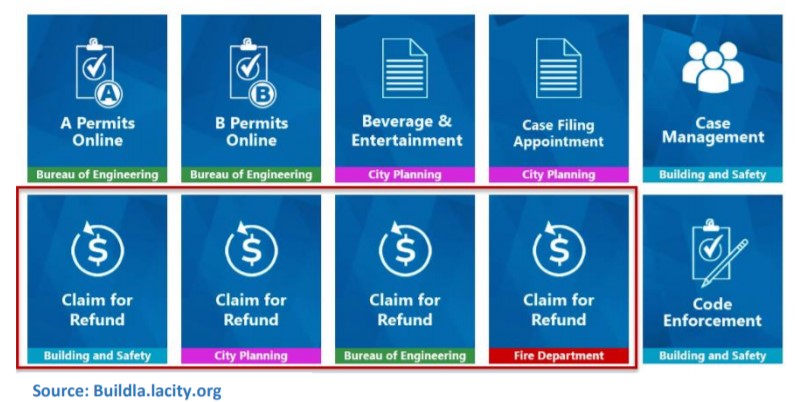
This is just one example of a digital design and development approach that reflects the City’s organizational priorities for designating responsibility. Designs like this do not emphasize a customer’s priority of getting something done, like obtaining a refund, regardless of which department processes the claim. For constituents navigating these bureaucratic hurdles, the City can feel like a series of departments rather than a unified organization, leading to frustrating experiences that can undermine trust in the City’s ability to deliver on its promises.
Overall, this points to the lack of a unified strategy for providing digital services in the City. Autonomous departments can pursue their own objectives independently, and prioritize developing and designing online services to meet their own needs. However, there may be lost opportunities to provide integrated services and a seamless customer experience in the overlap between departments.
Fortunately, a model already exists to help the City meet rising expectations for more and better digital services. Following the federal government’s failed launch of the healthcare.gov website in 2013, agencies such as the U.S. Digital Service and Technology Transformation Services were created to advise other federal agencies on digital transformation initiatives and develop web design standards to be adopted by agencies.
In addition, states and local governments throughout the country have begun adopting a digital services strategy and establishing digital services agencies to lead their efforts. For example, San Francisco published its digital services strategy in 2016. The planning document was the result of a lengthy effort to understand how various departments interact with the public in providing its services, the problems faced during those interactions, and the internal hurdles within the government to deliver better services.
In publishing its strategy, San Francisco arrived at a shared vision that:
- recognized the need to put residents first in the design of services;
- wanted to offer integrated services and an improved customer experience; and
- wanted to deliver those services digitally whenever possible.
The strategy also provided a high-level implementation roadmap, which included establishing a new digital services team that was empowered to lead the City’s efforts. Several years after adopting its strategy, San Francisco now has a digital services team with over 35 members. The team has begun a major overhaul of its collection of city websites. In addition, San Francisco is developing a digital permitting system from the ground up that unifies all building permit work from various departments into one online platform.
The idea of a digital services team is not new to the City. In 2015, the City’s Innovation and Performance Commission provided $150,000 in one-time funding for a digital services unit pilot program. The pilot was led by the Mayor’s Office in collaboration with ITA and resulted in the creation of several new digital products. More importantly, the digital services pilot also offered valuable insights for the City, including:
- the recognition that many digital services in the City were produced and designed without coordination or alignment;
- the need for a longer-term strategy around the City’s digital services, especially to improve user experience and adopt best practices; and
- the fact that solutions needed to be embedded within the City’s structure in order to be sustainable, such as by supporting and catalyzing ITA’s efforts.
In order to move its digital transformation forward, the City should apply the lessons learned from its experiment with a digital services unit and develop a longer-term digital services strategy. To address the need for better coordination and alignment, the strategy should be developed by a working group of departmental representatives. City organizations such as the Information Technology Oversight Committee or the Information Technology and General Services Committee may be an appropriate starting place for organizing these efforts and ensuring that the plan is ultimately implemented. However, the strategy should include input from members of the public to ensure that the strategy is centered on customer and end-user needs.
This planning effort should also deploy interviews, surveys, and focus groups, to develop a map of the City’s successes, challenges, and needs for implementing digital services, including digital equity issues. The strategy should result in shared goals for the City’s digital services and provide a high-level roadmap for implementation, which should include consideration for a new governance structure to sustain cross-departmental collaboration, and a dedicated digital services unit to provide leadership and implement the strategy.
Long-Term Changes Are Needed To Sustain Telework
Although the City has had a telecommuting program since 1994, departments seldom offered it to employees prior to COVID-19, and rarely considered its usefulness as a workforce management option. The rationale behind not implementing telecommuting widely likely mirrors the reasons offered by private sector employers, such as the inability to oversee employee productivity and reduced communication and collaboration with colleagues.
However, the City’s forced experiment with working from home has demonstrated that telework can be a viable workforce strategy that strengthens departmental operations when properly implemented. The City’s new teleworking infrastructure, combined with existing investments in online cloud platforms, appropriate training on remote work tools, and new supervisory practices has enabled much of the City’s workforce to continue working during the COVID-19 pandemic, and has made the City more resilient to emergency disruptions in general.
In addition, studies have shown many other potential benefits that the City should take advantage of with a more robust telework program. For example, the Personnel Department’s own Citywide survey found that more than 90 percent of City employees and their supervisors believed that their productivity had either stayed the same or increased since they started working from home.

Although telework research typically uses surveys of employees and supervisors to support the notion of increased productivity, one study actually measured it and found a 13 percent performance increase among teleworkers during a nine month experiment. The same study found an even higher performance increase (22 percent) among study participants who chose to continue working from home after the experiment ended.
However, telework studies also show that there is no single telework arrangement that is appropriate for all situations. For example, one study found that doing dull and repetitive tasks negatively impacted teleworking productivity while performing creative tasks resulted in an increase in performance. Depending on the type of work and the need for collaboration, personal preferences, and home situation, some employees may thrive in a work-from-home environment, while others may not find telework to be suitable for them in the long-run.
In addition, the business needs of an organization or a particular job position can result in many different telework frequencies, including:
- full-time telework;
- a mix of days in the office and routinely scheduled days at home;
- situationally for emergencies only; or
- to accommodate certain needs on a case-by-case basis
Given the complexities of formulating a workable approach to telework, the City should learn from the federal government’s leadership in telework practices. Even prior to COVID-19, 22 percent of the federal civilian workforce participated in telework on either a routine or situational basis in 2018, while 42 percent were eligible to participate.
The federal government’s preparedness is the result of laws passed by Congress, which includes several key features that provide institutional support for telework and promote it as a workforce strategy.
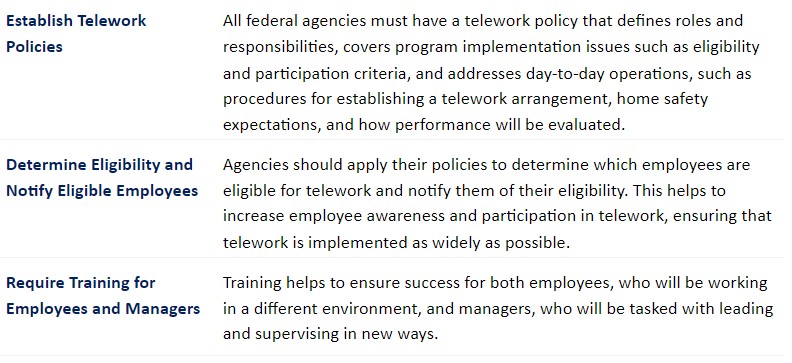

Most importantly, these requirements shifted the onus onto agency management to develop a plan for how their organizations would use telework. Federal agencies still retained discretion for defining workforce eligibility and participation criteria in their policies. However, the requirement to develop a policy — even one that limits telework to situational uses such as declared emergencies — meant that management had to determine when and how telework would fit into their organization’s operations.
This differs from the City’s telecommute program prior to COVID-19, where departments were not required to develop a policy for using telework. This lack of institutional support meant that City employees had to advocate for their own telecommuting arrangements, while few departments had prior knowledge on how to manage their workforce outside of the office.
To implement telework more sustainably, the City should follow up by adopting a framework of requirements and best practices modeled after the federal government’s successes. Doing so will help to ensure that the City is better prepared for the next emergency, while also leading to improved air quality, better recruitment and retention of talent, reduced real estate and office management costs, and foster greater workforce flexibility and productivity.
COVID-19 has created a new normal that the City is still navigating. However, that new reality is also one that includes more digital services than ever before. The City has demonstrated its ability to adapt and should continue rethinking its processes and creatively using technology to improve its customer service for all Angelenos. To build on these existing efforts, the recommendations in this report serve as a guide for developing a collaborative digital service strategy. In addition, the City support for telework as a workforce and business continuity strategy hinges on its adoption of the recommended best practices.
Recommendation #1
Consider developing and adopting a digital services strategy that includes the City’s overall vision, objectives, and plan for providing digital services for the public. At minimum, the strategy should include:
- creating or designating a working group or committee to guide the strategy’s development, consisting of staff from City departments, Council, and Mayor’s Office to promote collaboration and accountability;
- developing shared values and goals for the City’s digital services based on the successes and challenges of implementing services online. This effort should also include significant public input to address digital equity issues and the needs of the City’s customers and end-users; and
- establishing a high-level road map for achieving its goals, which should include consideration for a new governance structure, such as a committee that is empowered to prioritize and oversee digital service projects and promote collaboration across the City, and the need to create a digital services unit within the City that is dedicated to providing digital leadership in the City and implementing its strategy.
Recommendation #2
Implement program changes through executive or legislative action to adopt a framework of requirements — similar to those enacted at the federal level — that support telework as a viable workforce strategy for the City. At a minimum the City should:
- assign responsibilities to Personnel and the departments to support and implement telework Citywide, even as the pandemic eventually subsides;
- formally incorporate telework into its emergency planning processes;
- require all departments to develop a telework policy that includes eligibility and participation criteria;
- determine telework eligibility and inform all workers of their eligibility; and
- provide training to all employees and supervisors participating in telework to improve productivity and success.

